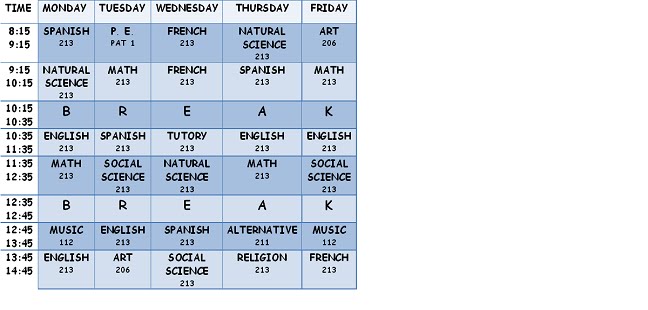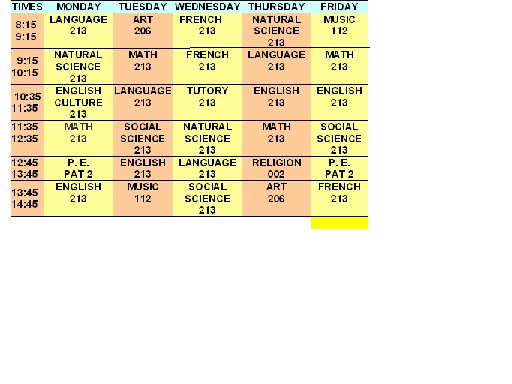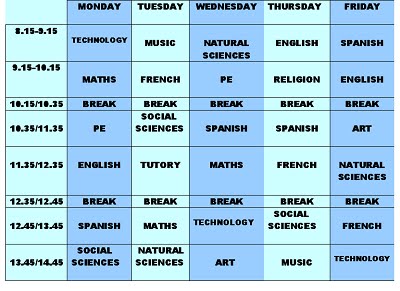Our teaching assistant, Alex, explained to the bilingual groups of 1º and 2º ESO the typical Easter traditions both in the UK and in the USA. As a project for the English class, some pupils decided to make some Easter crafts and they also prepared some traditional Easter meals like hot cross buns or chocolates. The results can be seen in the slideshow below.
Tuesday, April 6, 2010
British or American English?
The burning of Judas
The celebration of the burning of Judas is a popular festival that is held in Somontin, Almeria.The eighteen year-old youngsters climb a mountain and cut a tall and large pine tree. On Holy Saturday some teens take the tree down to the village and decorate it with old clothes and then they place dynamite, plants or branches next to it. On Easter Sunday after mass, they set fire to the tree and, as a result, the dynamite blows up. The resulting fire is seen as a symbol of purification. This celebration is also popular in other parts of Spain and in South America.
By Rosario Navío 1º ESO A-B
Easter traditions in the UK and in the USA
Easter is a very popular celebration in England and it has got a lot of traditions. For example, it’s very popular to hide eggs: parents hide them in the garden on Easter Sunday and then, they make their little children look for them.They tell them that the Easter Bunny has hidden them there. That tradition comes from many centuries ago, when people hid the eggs during Lent because they couldn’t eat them. Then, after Lent, they boil and decorate the eggs and they give them to each other as a symbol of the happiness of Easter.There is a similar tradition,called the egg hunt, that is the same but a lot of children look for eggs in a big place.
It’s common to eat hot cross buns on Good Friday: they are buns with a cross on the top that remind us that Jesus died on the cross.There is a popular race too: the egg and spoon race. There, children make the eggs roll down a hill and whoever’s egg goes the farthest without breaking , wins. This race is celebrated each year on the White House hill.
So,as you can see, there are a lot of ways to celebrate Easter in England or USA, because in Spain, we have the celebration of Holy Week.
It’s common to eat hot cross buns on Good Friday: they are buns with a cross on the top that remind us that Jesus died on the cross.There is a popular race too: the egg and spoon race. There, children make the eggs roll down a hill and whoever’s egg goes the farthest without breaking , wins. This race is celebrated each year on the White House hill.
So,as you can see, there are a lot of ways to celebrate Easter in England or USA, because in Spain, we have the celebration of Holy Week.
Wednesday, March 24, 2010
INTERNATIONAL WOMEN'S DAY
On March 8th our school, as many others worldwide, celebrated the International Women's Day. The bilingual students of 1º ESO made a project in which they had to research and write about some famous women from the past and from the present. Below you can see an example in the powerpoint made by Marta Quesada Villaescusa, Nerea Montañés Montaño and Luis Enrique Ruiz Carreño.
International Womens Day Project
View more presentations from Pedro Talavera.
Tuesday, March 9, 2010
THE EARTHQUAKE IN HAITI
The earthquake in Haiti happened on the 12th January 2010. The earthquake had a magnitude of 7.0 degrees on the Richter scale. This earthquake was the strongest recorded in the area since another in 1770, which measured 7.5 degrees. The bodies recovered since January 25th are more than 150,000, and the deaths recorded more than 200.000. There are also more than 250,000 injured and one million homeless. Now Puerto Príncipe is the poorest city in America.The survivors were transferred to the Dominican Republic.


WHY DID THE EARTHQUAKE IN HAITI HAPPEN?
The Caribbean plate has got a concave plate. It was a movement of this plate that caused the earthquake. It happened 15 km from the capital, at a depth of 8 km on the Enriquillo fault. Each year it separates one or two centimetres and there are little earthquakes, but there hadn’t been an earthquake for 167 years. The pressure had been accumulating until this year when it exploded and there was a big earthquake of 7.0 degrees.
By Sofía Bizi, 2º ESO
The Caribbean plate has got a concave plate. It was a movement of this plate that caused the earthquake. It happened 15 km from the capital, at a depth of 8 km on the Enriquillo fault. Each year it separates one or two centimetres and there are little earthquakes, but there hadn’t been an earthquake for 167 years. The pressure had been accumulating until this year when it exploded and there was a big earthquake of 7.0 degrees.
By Sofía Bizi, 2º ESO
Thursday, February 25, 2010
Andalucía's Day

 In 1981 a statute of autonomy was established which recognized the right to autonomy for the different Spanish regions and nationalities. In Andalucía this is celebrated on February 28th because the referendum that passed the statute took place on that date.
In 1981 a statute of autonomy was established which recognized the right to autonomy for the different Spanish regions and nationalities. In Andalucía this is celebrated on February 28th because the referendum that passed the statute took place on that date.Most schools commemorate this day with a typical Andalusian breakfast consisting of a sandwich with olive oil and sugar. In my school some students read articles of the Andalusian statute of autonomy while
 others hoist the two official flags . Andalucía's flag is green white and green.
others hoist the two official flags . Andalucía's flag is green white and green. The anthem of Andalucía talks about peace, hope and freedom in Andalucía, Spain and all over the world.
The coat of arms represents the figure of Hercules between two pillars,
traditionally identified with the Strait of Gibraltar, and it has an inscription at the bottom that says: "Andalucía by itself, for Spain and for the rest of
humanity”.
By Isabel de Sola 2º ESO A
The coat of arms represents the figure of Hercules between two pillars,
traditionally identified with the Strait of Gibraltar, and it has an inscription at the bottom that says: "Andalucía by itself, for Spain and for the rest of
humanity”.
By Isabel de Sola 2º ESO A
Subscribe to:
Posts (Atom)




